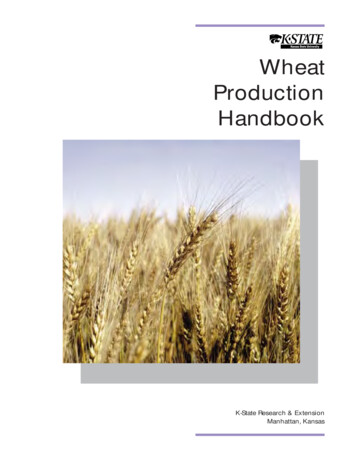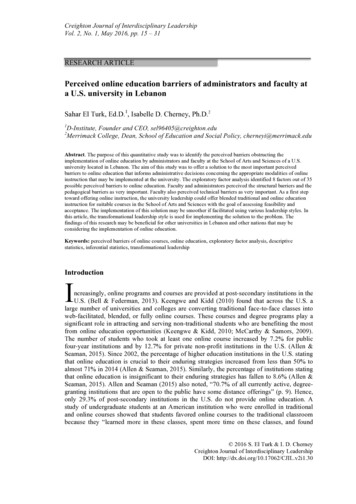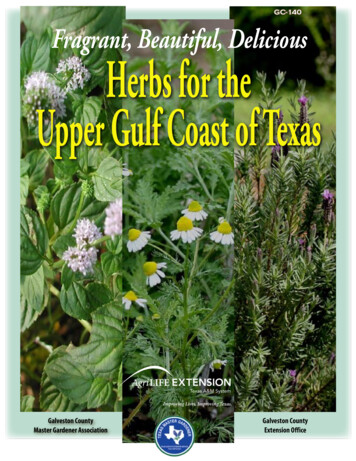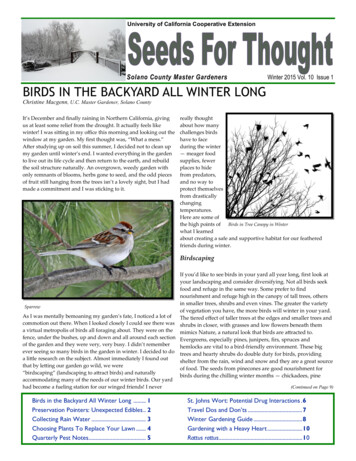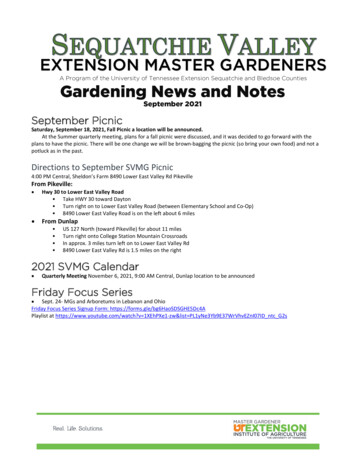
Transcription
EXTENSION MASTER GARDENERSA Program of the University of Tennessee Extension Sequatchie and Bledsoe CountiesGardening News and NotesSeptember 2021September PicnicSaturday, September 18, 2021, Fall Picnic a location will be announced.At the Summer quarterly meeting, plans for a fall picnic were discussed, and it was decided to go forward with theplans to have the picnic. There will be one change we will be brown-bagging the picnic (so bring your own food) and not apotluck as in the past.Directions to September SVMG Picnic4:00 PM Central, Sheldon’s Farm 8490 Lower East Valley Rd PikevilleFrom Pikeville: Hwy 30 to Lower East Valley Road Take HWY 30 toward Dayton Turn right on to Lower East Valley Road (between Elementary School and Co-Op) 8490 Lower East Valley Road is on the left about 6 milesFrom Dunlap US 127 North (toward Pikeville) for about 11 milesTurn right onto College Station Mountain CrossroadsIn approx. 3 miles turn left on to Lower East Valley Rd8490 Lower East Valley Rd is 1.5 miles on the right2021 SVMG Calendar Quarterly Meeting November 6, 2021, 9:00 AM Central, Dunlap location to be announcedFriday Focus Series Sept. 24- MGs and Arboretums in Lebanon and OhioFriday Focus Series Signup Form: https://forms.gle/bg6HaoSDSGHE5Dc4APlaylist at https://www.youtube.com/watch?v 1XEhPXe1-zw&list PL1yNe3Yb9E37WrVhvEZnI07ID ntc G2s
Sequatchie Valley Master GardenersSeptember 2021UT GardensPlant of the MonthOkra: A True Southern BeautyOkra (Abelmoschus esculentus) is a summertime staplefor many Tennessee farmers and home gardeners. Drivedown any local country road in late June through earlySeptember and you will probably spot a long row of tall,green branching plants with palmate leaves, creamy yellowflowers and seed pods shaped like thick, pointy fingers,thriving in the blazing summer sunshine. Likely originatingfrom modern day Ethiopia, this close relative of hibiscusand hollyhocks prefers hot weather, high humidity and arelatively long growing season, which makes it a perfect fitfor our summertime climate.The seeds can be sown directly in a prepared gardenbed once all danger of frost has passed and the soiltemperature has reached 65 degrees F or more. This warm‘Candle Fire’ okra can add beauty and interest to the garden with season annual can also be transplanted after startingred stems that can reach between 4 -6 feet tall with abundant seed indoors, just be sure to hold off on planting out until the airpods that are also an enticing red color. Photo by J. Reeves of aand soil are warm enough. Lean, dry soil conditions may bespecimen in the UT Gardens, Jackson, courtesy of UTIA.tolerated once plants are established, but providing amoist, well-drained, fertile growing medium will lead to abigger harvest. Provide 6-8 hours of direct sunlight and good air circulation to ensure healthy growth and to help preventpowdery mildew, which is a common late-season affliction.Although delicious fried, roasted, grilled, sautéed, or pickled, the tender pods are also delicious raw, with hummus orother dips, and sliced in salads. To catch the pods before they become tough, check often and harvest them young. Theexact size will vary depending on the variety, but they are generally best harvested when they are between 2-4 inches long.If they have become too mature, the seeds can be cooked like peas. During harvest season, it’s best to pick every other daybecause allowing the pods to mature on the plant will slow production. The plants can also be cut back midsummer tobetween 6-12 inches and side-dressed with an all-purpose, balanced fertilizer to rejuvenate them for an extended harvestthrough fall.Once you have had your fill of eating okra from these high-yielding plants, allow some pods to mature and drycompletely on the plant to use as an art supply for elegant and seasonal decorations or cute crafts for your kids. Imaginethem as Santa Claus, an angel, a gnome, or an accent for wreaths, or other creative decorations. The flowers are alsoattractive enough to be grown solely for their ornamental value. Varieties like the All-America Selections winner ‘CandleFire’ can add beauty and interest to the garden with red stems that can reach between 4-6 feet tall with abundant seedpods that are also an enticing red color. Although these cylindrical pods with smooth sides take longer than other varietiesto become tough, they are best harvested at about 3-4 inches long and with a diameter of about half an inch. This yearCandle Fire is on display at both the UT Gardens, Jackson, and the UT Gardens, Knoxville.‘Jambalaya’ is a choice selection for the culinary garden due to disease resistance, a stocky growth habit, and tendergreen spineless pods. The pods begin appearing a week or so earlier than other varieties at the Helping Hands KitchenGarden at the UT Gardens, Knoxville. Compact cultivars suited for smaller spaces or raised beds are also available.2
Sequatchie Valley Master GardenersSeptember 2021Gardening Tips“Gardening requires lots of water - most of it in the form of perspiration.”Lou EricksonOctober GardeningOctober is typically the driest month in Tennessee so be sure to keep your garden watered. Here are some tips from theUniversity of Tennessee Institute of Agriculture for fall garden maintenance:Shrubs and trees You’ll find a good supply of trees and shrubs at local suppliers and October is just the beginning of the ideal season toinstall such plants in your garden. If you do plant in October, definitely water plants well until rainfall picks up inNovember and December.Perennials, annuals, and bulbs One last effort at weeding will help to improve the appearance of your garden throughout the winter. Any weed whichyou can eliminate from the garden this fall will possibly prevent thousands of weed seeds from sprouting in the gardennext spring!Garden centers and nurseries are well stocked with spring-flowering bulbs and late October and early November arethe ideal time to get them planted.Collect and save seeds of wildflowers to sow either right now allowing the seeds to over-winter in your garden or waitand sow early next spring.Now is an ideal time to plant winter annuals in your garden for a great show of color from now until spring. Greatplants to include in your winter garden are pansies, violas, snapdragons, and Dianthus. They can be planted in mass fora major splash of color in your landscape or use in containers to add color in different strategic spots. Such winterhardy herbs as parsley, thyme, and rosemary make great container companions with winter annuals. Also, considerinterplanting your winter annuals with bulbs of daffodils, tulips, and hyacinths. Planting bulbs between such hardyannuals will bring a surprise burst of color in the spring. And when the fading bulb’s foliage begins to wither, the winterannuals are so colorful that one barely notices the bulbs’ yellowing foliage.It’s a good time to spruce up your garden by cutting back withering perennial blooms and adding a fresh layer of mulch.If you do add new mulch, be sure to follow up with a pre-emergent herbicide to prevent an invasion of winter weeds.Mums are here. A variety of sizes and colors await your garden. Some people grow mums as year-round perennials,often enjoying two seasons of blooms–a light display in late spring, and another show in the fall. Others opt for treatingthem as fall annuals, sinking pots in the ground, or among their other garden plants. Either way, mums are a great wayto add extra color to the fall garden.Keep your garden and lawn raked clean of a heavy layer of leaves and debris. Fallen leaves, old plant parts, and grassclippings should be added to the compost pile.Lawn care Fall is an ideal time to renew tall fescue lawns that have suffered during hot, dry summer months. Fertilizing withnitrogen-containing fertilizers will speed lawngrass growth, thicken the lawn and improve its’ color.Seeding and mulching bare areas will provide erosion control and reduce the potential for weed problems.Core aerifying will help water and nutrients move into hard soils. If your lawn is weak and thin and you intend to seed,a power rake can be used to lift thatch and expose soil before planting. Now may be the time to introduce a new,improved variety of tall fescue blend. It is best to be done with seeding your lawn by mid-October but fertilizer can beapplied as late as mid-December.It is not too late to prepare your bermudagrass or Zoysia lawn for winter this fall. By increasing the cutting height now,you can help buffer these lawn grasses from extremely low temperatures in winter. The application of a potassiumcontaining fertilizer may also improve your lawns’ low temperature hardiness and drought tolerance. Several fertilizersare specially formulated to help “winterize” bermudagrass and Zoysia. Some may also contain a pre-emergenceherbicide to prevent seeds of annual bluegrass and other winter annual weeds from germinating and competing withlawn grasses for light, nutrients, and water.3
Sequatchie Valley Master GardenersSeptember 2021Fruits and Veggies Pumpkins, summer squashes, and gourds to be stored should be harvested before the first frost. Pumpkins that havebegun showing color will continue to ripen after harvest. Use great care not to nick the rind during harvest since thiswill lead to more rapid deterioration.Dig and divide congested clumps of rhubarb.Apple varieties are showing up at fresh markets and roadside stands. Seek out some new varieties to eat fresh orcreate delicious desserts with. Apple trees can be planted now, too. Select disease-resistant ones such as Redfree,Prima, Priscilla, Jonafree, Nova Easygro, and Liberty.Keep harvesting second plantings of the cool season vegetables including radishes, lettuce, Chinese cabbage, chard,spinach, broccoli, and the other cole crops. Some such as parsnips, Brussels sprouts, and kale have enhanced flavorafter a frost.Plant individual cloves of garlic now for a crop of garlic bulbs next summer. Select very large cloves to produce thelargest bulbs. Plant them 6" deep and at least 6" apart. Mulch them after the ground freezes for winter protection.Some root crops, such as carrots, onions, and parsnips can be left in the ground and dug up as needed. Apply enoughmulch to keep the ground from freezing, and the crop will be kept fresh until it is needed.If diseases or insects wiped out your peach or other fruit crops this year, cleanup is called for. Destroy any fallen fruitfrom under your trees, and remove any that have mummified on the tree. These fruits will be loaded with problems,and cause an early attack next year. Consider getting a home fruit spray schedule from your local extension office now,so you are prepared next year.After you have finished harvesting your summer vegetables, plant a cover crop of clovers, cowpeas, soybeans, orvetches to plow under next spring. These nitrogen-producing plants will provide good organic matter and food for yourgarden crops next year, as well as helping to control weeds over the winter.Odds and ends Now is a great time to do fall decorating in your garden which works well all season long, from the first hint of cool airand autumn color to late November and Thanksgiving. The key is making displays that use the traditional icons of fall hay bales, scarecrows, corn-stalks - as supporting cast for the lead players - pumpkins, gourds, Indian corn, garden, orpot mums, fall pansies, asters, ornamental kale, and other blooming plants. Hay bales are especially useful “benches”for building versatile displays, while corn-stalks add height and definition. Such displays can add a festive touch to afront porch or the landscape in strategic places like a light post or the entrance to a driveway or walk.Place amaryllis in storage for a 2-month rest before re-flowering. Select a cool (40 - 50 degree) spot and stop allwatering. Plan to begin watering again 9 -12 weeks before you want it to flower.Thanksgiving and Christmas cactus should be placed in an east or north window, watered, and fertilized one last time.Start letting them dry out more between waterings. This plus cooler night temperatures will stimulate blossomproduction.Compost has been compared to black gold and will make quite a difference in your soil. Fall is the ideal time to start acompost pile since there is such a ready supply of materials–from falling leaves to the gleanings from our vegetable andflower gardens. Your local extension office has loads of material on composting, from building the compost structure,to how to compost.The birds will soon begin their winter migrations so give them a helping hand by providing them with some food fortheir long journey. You might persuade a few of them to stick around for the winter if they know they have a reliablefood source!4
Sequatchie Valley Master GardenersSeptember 2021Are Fall ArmywormsInvading Your Yard?UT Entomologist Provides Tips onDefeating the Small, but Mighty, PestIf you look at your grass closely right now, youmight see the blades moving. That is not just thebreeze — it’s a caterpillar known as the fallarmyworm.“This year has been an unusual year. They’reworse than anybody I’ve talked with canremember,” said Scott Stewart, an entomologistA fall armyworm eats grass in a field at the West Tennessee AgResearch and with the University of Tennessee Institute ofEducation Center in Jackson, Tenn. This was one of thousands discovered in Agriculture.the grass outside the center. Photo courtesy UTIA.The armyworm isthe caterpillar of the fall armyworm moth. It feeds primarily on grass, fresh sod, hayfields, and other summer and fall crops.However, you may see the most problems with Bermudagrass and pastures. An armyworm’s life span is about twelve days,with the last couple of days being the period where armyworms eat the most. Quickly, they turn lawns brown and patchy.Stewart says the armyworms may leave your yard when the food runs out. However, your yard will stay brown forquite a few days before it regenerates, and you could see the armyworms pop up a second time. If you want to eliminatethe pest before that happens, you’ll need to invest in an insecticide. Those can be found at most home improvementstores or garden centers.“Unfortunately, you may have to make more than one insecticide application when they are as prevalent as right now,”Stewart said, “However, insecticides are very safe and effective if you use them according to the label. There areseveral options, so you might want to get suggestions from your local garden center or county Extension agent. The otheroption is to let them eat. Your yard may not look too good for a little while, but a healthy, established lawn will recover.”The Extension Master Gardener Program is a program of the University of Tennessee ExtensionSheldon BarkerCounty Director & Extension AgentSequatchie Co.170 Church StDunlap, TN 37327423-949-2611UT Extension Sequatchie County web pageSequatchie County FacebookJ. C. RainsCounty Director & Extension AgentBledsoe Co.PO Box 289Pikeville, TN 37367423-447-2451UT-TSU Extension Bledsoe County WebpageBledsoe County Facebook5
Sep 10, 2020 · A Program of the University of Tennessee Extension Sequatchie and Bledsoe Counties . EXTENSION MASTER GARDENERS . . 8490 Lower East Valley Road is on the left about 6 miles . Collect and save seeds of wildflowers to sow either right now


